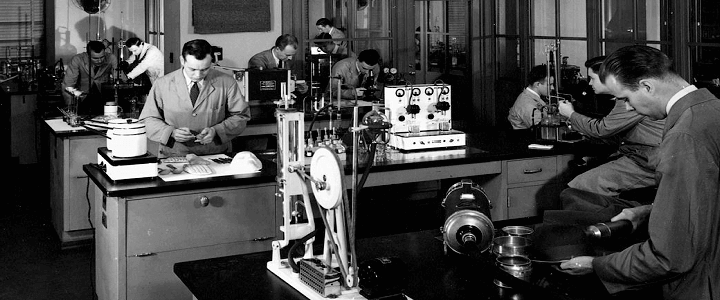It is almost my first anniversary of starting to write for ClearanceJobs, which means yesterday was the first anniversary of the day we buried my father. As my brother has said, I don’t want to be “that guy” who waxes poetic about his dad every year… and I won’t be. But the occasion gave me the idea to tell a story about how I got to be where I am — that is, a retired Army officer working as a government contractor, the third generation of my family to contract.
The story isn’t really about my father, but his father. William D. McCuin was born in Boston in 1914, the second son and fourth child of an Irish immigrant and a former farmer from far northern New York who worked as a motorman for the Boston Elevated Railway. Bill spent his youth moving back and forth between Boston’s Dorchester neighborhood and his father’s hometown of Brasher’s Falls.
His father died of typhoid fever in 1929, a disease that almost claimed his sister at the same time. With the outbreak of the Second World War, he moved to Frederick, Md. to work as a contracting officer for the Army at what was then called Camp Detrick. When I was young, he told me his job was to buy toilet paper for the soldiers on the installation. When I was older, he admitted that his job was to acquire materials that the scientists studying biological warfare needed to conduct their experiments, while making them look like innocuous purchases for other purposes.
Gottlieb’s Party at Deep Creek Lake
His best friend at Detrick was an Army scientist, Dr. Frank Olson. Some time around or just before 1953, Olson and my grandfather joined the Central Intelligence Agency, working on the Technical Services Staff. They were part of a program that remains shrouded in mystery even though it has been the subject of a number of documentaries: Project MK-ULTRA.
Under the direction of Dr. Sidney Gottlieb and Dr. Robert Lashbrook, MK-ULTRA is now better known as the CIA’s “mind control” program. The team was looking for drugs that could serve as a “truth serum” during interrogations, or even create the “Manchurian Candidate,” an enemy soldier or intelligence operative brainwashed into working for the other side. The majority of their experiments focused on the effects of lysergic acid diethylamide, better known as LSD.
On November 18, 1953, Gottlieb and Lashbrook arranged for a group of CIA employees, my grandfather and Olson among them, to attend a working retreat at Deep Creek Lake in western Maryland. After dinner, Gottlieb served the men Cointreau spiked with LSD in order to observe their behavior while under the influence. Frank Olson never recovered from the experience.
He became depressed and anxious, developed severe paranoia, and suffered what at the time was called a “nervous breakdown.” The next week, he traveled with Lashbrook to New York City to visit Harold Abramson, a doctor on the CIA’s payroll. The men stayed at the Stadler Hotel, now called the Hotel Pennsylvania, across the street from Penn Station.
On November 26, Thanksgiving Day, Olson fell to his death from his room on the hotel’s 10th floor. It was officially ruled a suicide; Olson’s son Eric believes Lashbrook pushed him.
20 Years of Silence
Eric Olson and his family spent the next 22 years wondering what had led to Frank’s sudden change in behavior, and what had driven him to commit suicide. Following the Watergate scandal, Congress and the executive branch conducted several investigations into CIA domestic activities. One of them, the United States President’s Commission on CIA Activities within the United States, chaired by Vice President Nelson Rockefeller and better-known as the Rockefeller Commission, included a summary of Olson’s case in its 1975 report.
The report didn’t mention Olson by name, but his family revealed his identity to Seymour Hersh, then writing for the New York Times, in July of 1975. I remember Frank’s widow Alice visiting my grandparents’ house in suburban Philadelphia around this time. After threatening to sue, the government paid the Olsons a $750,000 settlement. Alice also received an apology from President Gerald Ford and Director of Central Intelligence William Colby.
Alice died in August 1993 at the age of 77, but Eric hasn’t stopped trying to uncover what happened that night in Manhattan. In 1994, the Olsons had Frank’s body exhumed to be buried with their mother, and to perform a second autopsy. The coroner in that case determined that contrary to the government’s story, Olson had been murdered.
We may never learn the full story. Most of the principal actors are long dead, and Gottlieb destroyed most of the MK-ULTRA files. But like many things connected with the CIA during the Cold War, there’s definitely more to the story.
I’m not sure when my grandfather left the CIA. Part of me suspects that the company he founded — SIC, Inc., which stood for security, intelligence, and communications – to produce surveillance equipment for government agencies – was a CIA front company. My father took the helm at SIC in 1984 following my grandfather’s death. If the evidence existed, he took it to the grave with him last year.
My conspiracy theory-loving children are fascinated by this facet (and a few others) of family history. But to me, it’s just part of my childhood, which was spent around “cops and spies.” So if you want to know why I’m a defense contractor, the apple doesn’t fall far from the tree.




